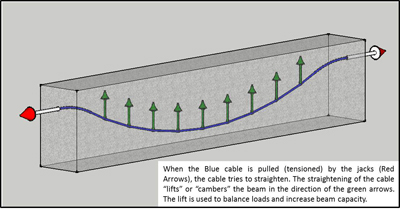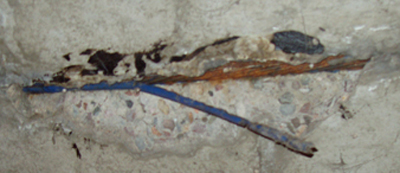Safety Considerations. Condominium, townhouse and highrise construction often incorporate post-tensioned concrete. This creates serious considerations when it comes to owner remodel projects and general maintenance issues. Careless drilling through a concrete slab could result in injuries as well serious degradation of structural strength of the slab.
Description of Post-Tensioning. Concrete is a material with incredible compressive strength but limited tensile strength. Prior to the development of post-tensioning techniques the effectiveness of concrete was limited to short spans. The advent of post-tensioned concrete allowed longer slab spans and thinner sections. With post-tensioned construction, steel cables are placed in the slab and stretched from one end of the slab to the other. The cables are secured at each end with anchoring systems made of steel castings. When tensioned (stretched) and locked-off to the anchors, the post-tensioned system (i) increases the capacity of the slab and (ii) reduces "sag" by lifting the slab. This allows slab spans to increase and/or slab thickness to decrease.

Maintenance considerations for associations include the following:
-
Shortening: Because they are “pre-compressed”, post-tensioned slabs continue shortening for a 3 to 5 year period after initial construction as they cure. Rigid elements connected to the slabs such as concrete or masonry walls may develop shear cracking during this time.
As shown in the photo below, the shortening of the slab can create maintenance issues for the wall and other connected elements. While some cracking is acceptable, excessive cracking can result in spalling concrete and allow moisture to reach the reinforcing steel, causing rusting of the rebar and continued deterioration of the concrete and masonry elements.
-
Deterioration of the Anchors: After tensioning the cables, initial shortening effects are greater for the initial 14 to 60 day period. This often results in the use of of delay strips, typically 30-inches wide in the slabs, filled with concrete 30 to 60 days after post-tensioning. Because these delay strips contain the anchor plates for the tendons, and there is a continued process of shortening within the slabs, it is very important that the delay strips are properly sealed and maintained to prevent carbonation or entry of water and anchor deterioration.
As the slabs continue to shrink over time the delay strips are critical areas to observe and maintain on a regular basis. Improperly sealed joints, especially those suffering from deferred maintenance, are susceptible to moisture and water infiltration. Excessive moisture can lead to damage to the tendon anchor zones and deterioration of the concrete and reinforcing steel.
-
Future Construction Coring or Cutting: Post-tensioned tendons are wrapped in a plastic coating to prevent the bond between the tendon and concrete. Unlike conventional rebar, this means that if the tendon is cut or damaged it loses its effectiveness over the entire length of the tendon. Therefore, future construction requiring cutting or coring of the slab must proceed very carefully. Such work can be safely performed only after tendon locations have been verified with the use of X-ray or ground penetrating radar (GPR) equipment. When new projects anticipate the use of post-tensioned slabs, design criteria should be established, confirmed, and specified noting the maximum length of post-installed anchors (drilled anchors or shot pins) to prevent nicking or otherwise damaging a tendon.
As shown in the beam example diagram, the tendons create lift to balance the imposed loads. If a tendon is cut the “lifting” action is lost and the beam loses the ability to support loads. This can severely impact the integrity of the post-tensioned system.
-
Weatherproofing: Due to the need to access the tendon anchors for stressing and locking-off operations, the majority of anchors are located at the perimeter of the slab. Because of the vulnerability of the tendon anchors around the perimeter of building exposed to weather, additional precaution and maintenance inspection is warranted to ensure the proper condition of the anchors. In coastal and tropical, or high humidity regions of the world additional concrete cover and corrosion protection is highly recommended to protect both the anchors and tendons.
Poorly installed waterproofing or lack of adequate maintenance of waterproofing membranes, often in planters on plaza deck of condominium projects can be as detrimental to tendons as is cutting a tendon. As shown in the included photo, the moisture attack on the tendons can result in severe damage and eventually complete loss of the tendons. Fortunately evidence of this type of damage can be observed, usually in advance of critical failure, during regularly scheduled maintenance programs.

Observing Distress in post-tensioned slabs is often an indication that one or more of the above mentioned issues is of concern. Distress is often manifested by signs of anchor plugs popping out of the slab edge, evidence of rusting along the delay strip seams, spalled concrete also with signs of rust, and shear crack in concrete or masonry walls located toward the ends of the slabs. If any of these indicators is observed, a structural engineer should be contacted for an inspection and report.
Recommendation: To protect themselves from potential liability, associations with post-tensioned slabs should adopt written guidelines addressing both maintenance and remodel issues.
-
Remodel Safety. Boards should adopt architectural standards that prohibit drilling, coring or cutting into concrete slabs without the association's approval with only after cable locations have been verified with the use of X-ray or ground penetrating radar (GPR) equipment. Owners who alter common area slabs should also sign an agreement holding the association harmless and indemnifying the association in the event damages one of the cables.
-
Maintenance & Reserves. In addition, boards should adopt written guidelines for regular inspection and maintenance of post-tensioned slabs. Since maintenance costs will be periodic in nature, they can be incorporated into the association's reserve study. Doing so will also trigger important periodic visual inspections.
Information submitted by Kenneth O’Dell, P.E., S.E. Partner with MHP, Inc. Structural Engineers.
ASSISTANCE: Associations needing legal assistance can contact us. To stay current with issues affecting community associations, subscribe to the Davis-Stirling Newsletter.